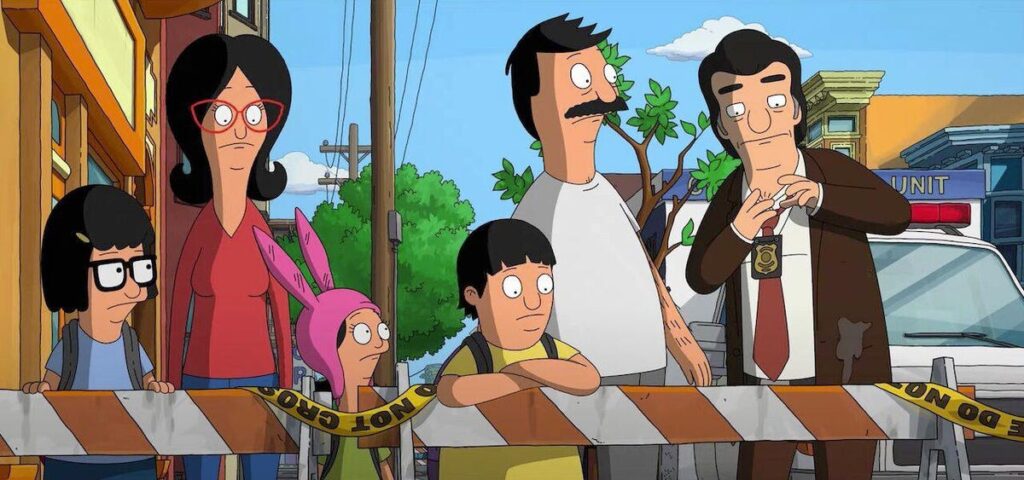“The Bob’s Burgers Movie” is Animated in 2D; Here’s Why It’s Such a Big Deal

by Emily Nagle

When “The Bob’s Burgers Movie” was served up to theaters on Memorial Day weekend, it made history as Disney’s first 2D feature-length film in over a decade, with their last animated feature being “Winnie the Pooh” back in 2011. Although the latter was produced by Disney’s own animation studios, while “Bob’s Burgers” is a product of their 20th Century Animation subsidiary, it’s still a breath of fresh air seeing a 2D film in theaters. Traditional animation used to be the standard, but now, in the age of Pixar and Dreamworks, fully 2D productions are hard to come by in movie theaters.
In an interview with The Illuminerdi back in April, series creator Loren Bouchard revealed the reasoning behind the film’s 2D visual style, explaining that he wanted it to feel like part of the series. He also mentioned how CGI has slowly become the unspoken norm for animated features.
“It’s not 3D. We didn’t change how we do the show,” Bouchard told interviewers. “It’s just a 2D movie, a lovingly made 2D movie, but just with more artists and more time and more care on each background, on each character…It looks to us, hopefully it does to the audience too, like some of the classic 2D movies. Which they’re not making that many of these days. So, we’re very aware that we’re part of a great tradition of filmmaking and we hope that the audience comes and sees that as something worthwhile. And that not everything has to be a CG movie. No offense to CG movies, you’re lovely. I watch you too.”
Bouchard is right – the animation creates a nostalgic feel reminiscent of films from the early 2000s. It reminds me the most of The Simpsons Movie, another summer blockbuster based on a popular adult cartoon. Just like “Bob’s Burgers”, it’s animated in a hand-drawn style to stay true to the long-running Fox animated series, even during scenes that appear 3D (including this impressive scene of an angry mob accosting the Simpsons’ home, which pans through the crowd to show over 300 distinct characters from the franchise!). The characters look the same as they do in the show, except slightly more detailed, with the addition of more shadows and enhanced lighting. When projected onto the big screen, the end result is stunning, eye-popping animation.
When creating a film based on preexisting properties, studios face a unique dilemma: what medium will they use to tell their story? Groening and Bouchard both elected to stick with traditional animation for their films in order to stay true to the series. Sticking to what people know is the usual approach animated franchises take when they make their foray into the feature film world. People cherish familiarity, and see the feature film as a slightly longer story with the characters they know and love.
For example, let’s go back to a title I mentioned earlier: Winnie the Pooh. Having been created entirely with hand-drawn animation, this sweet summer film ended up resonating with viewers young and old. The gentle, storybook-esque animation complements a tender story featuring one of the most well-known fictional characters of the last century. This made it hit home not just for kids, but also for their parents, who knew the Hundred Acre Wood friends from their own childhoods.

Some franchises have gone the opposite route, experimenting with a new medium for their trip to the big screen. The SpongeBob Movie: Sponge Out of Water is an example of this; while the franchise’s first feature film over a decade prior used only traditional animation, this time the creative team dipped their toe into the CGI realm. The first half of the film features the Bikini Bottom gang in their usual 2D style, but when the gaggle of sea creatures makes their way out of the ocean, they are depicted in a CGI style as they navigate a live-action environment.
There’s nothing wrong with taking a mixed-media approach; it keeps viewers on their toes, and can put a new spin on the franchise. It certainly worked for Sponge Out of Water; critics praised the CGI, and personally, I got a kick out of seeing these cartoon characters in a completely different visual style. They didn’t look creepy (I’m looking at you, Sonic the Hedgehog). Instead, the 3D look added a whole new texture to the characters.

Despite this, a switched-up visual style is not always received well by audiences; many viewers found the computer-animated depictions of Timmy’s fairy godparents for one of Nickelodeon’s earlier projects, A Fairly Odd Movie: Grow Up, Timmy Turner!, to be lazy, appearing out of place against the live-action backdrop (however, it is a made-for-TV movie, so the team had less resources and budget). With that being said, the end product for a switched-up animation style really depends on how it’s executed.
So, what does the success of “The Bob’s Burgers Movie” mean for the future of animation? While it hasn’t broken the box office like “Top Gun: Maverick“, this movie is a big deal because it proves that 2D animation still has so much room for creativity, especially on the big screen. My hope is that other studios will go back to their roots, and give traditional animation another shot. CGI is improving rapidly, and has brought some incredible stories to life, but there’s something special about traditional animation. Every single detail, from shadows to textures, is placed there deliberately by a person, rather than being automatically generated by a computer. And that’s pretty incredible to think about.